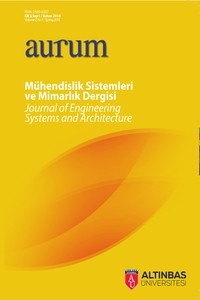Learning Through Graphic Communication on The Verge Of Digital Era/Dijital Çağın Eşiğinde Grafik İletişim Yoluyla Öğrenme
Tasarım, Temsil, Stüdyo, Sayısal ortam, Örtük bilgi, Açık bilgi
Learning Through Graphic Communication on The Verge Of Digital Era/Dijital Çağın Eşiğinde Grafik İletişim Yoluyla Öğrenme
Design, Representation, Studio, Digital media, Tacit knowledge, Explicit knowledge,
___
- Badocarro, J. L. 1991. The knowledge link. Harvard Business School Press, Boston.
- Blackburn, S. 1994. The Oxford Dictionary of Philosophy. Oxford University Press, Oxford UK.
- Brereton, M. 2004. Distributed Cognition in Engineering Design: Negotiating between Abstract and Material Representations. Springer, London, 84-87.
- Brown, J. S., and Duguid, P. 1996. Organizational learning and communities-of-practice: Toward a unified view of working, learning, and innovation, In Cohen, M. D. and Sproull, L. S. (eds), Organizational learning. Sage Publications, London, UK, 58–82.
- Dewey, J. 1957. Experience and Education. MacMillan New York NY.
- Dewey, J. 1960. The quest for certainty a study of the relation of knowledge and action. Putnam, New York.
- Grene, M. 1969. Knowing and being Essays by Michael Polanyi. Routledge and Kegan, London UK.
- Heylighen, A., Neuckermans, H., and Bouwen, J. E. 1999. Walking on a Thin Line-Between Passive Knowledge and Active Knowing of Components and Concepts in Architectural Design. Design Studies, Elsevier, 212.
- James, W. 1971. The meaning of truth: a sequel to pragmatism. Greenwood Press, Westpoint CT. Kant, I. 1966. Critique of the Pure Reason. The Doubleday Garden City, NY.
- Kierkegaard, S., Sartre, J. P., Wilde, J. T., and Kimmel, W. 1962. The search for being: essays from Kierkegaard to Sartre on the problem of existence. Noonday Press, New York.
- Lawson, B. 1980. How Designers Think. The Architectural Press, London.
- Marx, K. 1961. Economic and Philosophical Manuscripts. Ungar, New York NY.
- Orr, J. E. 1996. Talking about machines. An ethnography of a modern job. Cornell University Press, London, UK.
- Oxman, R. 1997. Design by Re-representation: a model of visual reasoning in design. Design Studies (18), 329-332.
- Oxman, R. 2001. The mind in design: a conceptual framework for cognitionin design education. Elsevier, London.
- Polanyi, M. 1964. Personal knowledge. Harper and Row, New York, NY.
- Polanyi, M. 1967. The tacit dimension. Doubleday Books, Garden City, NY.
- Schön, D. A. 1983. The Reflective Practitioner: How Professionals Think in Action Basic. Books, New York.
- Schön, D. A. 1993. The reflective practitioner. How professionals think in action. Basic Books, New York, NY.
- Sternberg, R. J., Conway, B., Ketron, J., and Bernstein, M. 1981. People’s conceptions of intelligence. Journal of Personality and Social Psychology, (41), 37–55.
- Thagard, P. 1996. Mind: Introduction to cognitive science. MIT Press, Cambridge, MA, 295.
- Kolarevic, B. 2009. Integrated Design: From Digital to Material. Arab Society for Computer Aided Architectural Design (ASCAAD Conference University of Bahrain, Manama, Bahrain.
- ISSN: 2564-6397
- Yayın Aralığı: Yılda 2 Sayı
- Başlangıç: 2017
- Yayıncı: Altınbaş Üniversitesi
Sefer KURNAZ, Mohanad Mohammed ABDULKAREEM, Shadha Adnan YASEEN
Ali Majid NOOR, Osman Nuri UÇAN, Oğuz BAYAT
TÜRKIYE’YE ÖZGÜ BITKI VE GIDA ÖRNEKLERININ TEMEL BILEŞENLER ANALIZIYLE SINIFLANDIRILMASI
MATLAB, PHYTON VEYA R KULLANARAK WEB TABANLI BÜYÜK MOLEKÜLER VERI DÖNÜŞÜM ANALIZI
POLIGON MODELLEME İLE ÖYKÜ OLUŞTURMA
UYDU VERILERINE DAYALI OLARAK BITKI ÖRTÜSÜ ANALIZI
Nagihan ESENDAL BOZKURT, Metin ZONTUL, Zafer ASLAN
ÖNCÜL BILGI TABANLI KAN PAYLAŞIM SISTEMI TASARIM VE UYGULAMASI
